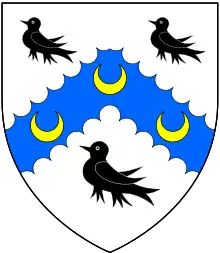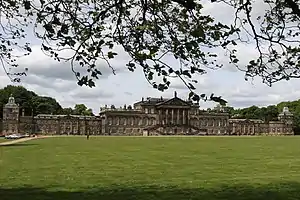Thomas Watson-Wentworth, 1st Marquess of Rockingham
Thomas Watson-Wentworth, 1st Marquess of Rockingham, KB, PC (I) (13 November 1693 – 14 December 1750) of Wentworth Woodhouse, Yorkshire was a British Whig politician who sat in the House of Commons from 1715 until 1728 when he was raised to the Peerage as Baron Malton.

Early life

Watson-Wentworth was born at Tidmington, Worcestershire the only son and heir of the Hon. Thomas Watson (later Watson-Wentworth, the third son of Edward Watson, 2nd Baron Rockingham) and his wife, Alice Proby, a daughter of Sir Thomas Proby, 1st Baronet. He was admitted at St John’s College, Cambridge on 15 May 1707 and was awarded MA in 1708.[1] In 1708, he bought Hallfield House, near Sheffield. On 22 September 1716, he married Lady Mary Finch, a daughter of Daniel Finch, 2nd Earl of Nottingham, and his second wife, Ann Hatton. He succeeded his father to Wentworth Woodhouse in 1723, remodelling the house to its present form.[2]
Career
At the 1715 general election, Watson-Wentworth was elected in a contest as Member of Parliament for the family borough of Malton. He was returned again unopposed at the 1722 general election. On the death of his father in 1723 he set himself up as leader of the Whigs in Yorkshire. In 1725, he was appointed a Knight of the Bath. At the 1727 general election he was returned unopposed as MP for Yorkshire instead. In 1728, he was created Baron Malton and vacated his seat in the House of Commons.[2]
At this time, now Lord Malton, he deliberately burned most of the manuscripts left by the 17th-century antiquary Richard Gascoigne; this act has been attributed to legal advice from his attorney.[3] He was admitted to the Privy Council of Ireland in 1733 and was Lord Lieutenant of the West Riding of Yorkshire from 1733 to 1750. In 1734, he was created Earl of Malton, and in 1746, Marquess of Rockingham. He had inherited the Barony of Rockingham and Rockingham Castle from his cousin, Thomas Watson, 3rd Earl of Rockingham, earlier in 1746.[2]
Family
.jpg.webp)
Lord Rockingham died on 14 December 1750, according to Walpole 'drowned in claret',[2] and was buried in York Minster.[1] He and his wife Mary had five children:
- William, styled Viscount Higham (1728–1739).
- Charles, 2nd Marquess of Rockingham (1730–1782), Prime Minister of Great Britain.
- Lady Anne (d. 1769), married William Fitzwilliam, 3rd Earl Fitzwilliam.
- Lady Mary, married John Milbanke.
- Lady Henrietta Alicia, married William Sturgeon.
References
- "Wentworth, Thomas (WNTT707T)". A Cambridge Alumni Database. University of Cambridge.
- "WATSON WENTWORTH, Thomas (1693-1750), of Wentworth Woodhouse, Yorks". History of Parliament Online. Retrieved 19 March 2013.
- Pearson, R. E. O. "Gascoigne, Richard". Oxford Dictionary of National Biography (online ed.). Oxford University Press. doi:10.1093/ref:odnb/10423. (Subscription or UK public library membership required.)
| Parliament of Great Britain | ||
|---|---|---|
| Preceded by William Palmes Hon. Thomas Watson-Wentworth |
Member of Parliament for Malton 1715–1727 With: Hon. Thomas Watson-Wentworth 1715–22 Sir William Strickland, Bt. 1722–24 Hon. Henry Finch 1724–27 |
Succeeded by Hon. Henry Finch Wardell Westby |
| Preceded by The Viscount Downe Cholmley Turner |
Member of Parliament for Yorkshire 1727–1728 With: Cholmley Turner |
Succeeded by Cholmley Turner Sir George Savile, Bt |
| Honorary titles | ||
| Preceded by The Earl of Burlington |
Lord Lieutenant of the West Riding of Yorkshire 1733–1750 |
Succeeded by The Marquess of Rockingham |
| Custos Rotulorum of the North Riding of Yorkshire 1733–1750 | ||
| Peerage of Great Britain | ||
| New creation | Marquess of Rockingham 1746–1750 |
Succeeded by Charles Watson-Wentworth |
| Earl of Malton 1734–1750 | ||
| Baron Malton 1728–1750 | ||
| Peerage of England | ||
| Preceded by Thomas Watson |
Baron Rockingham 1746–1750 |
Succeeded by Charles Watson-Wentworth |